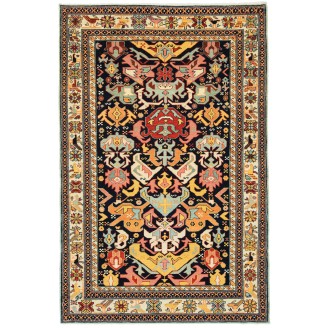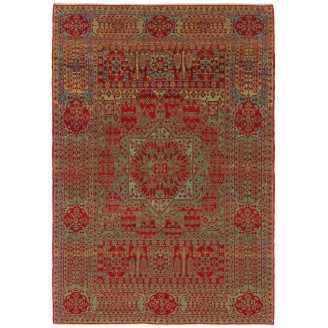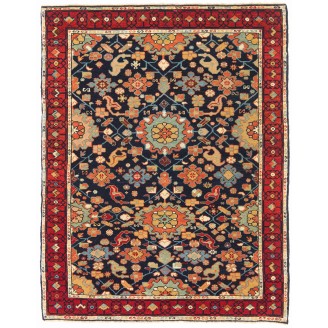Model: ART00758
Dimensions: 4'4" X 6'0"(134cm x 183cm)
Exquisite Cairene Ottoman Carpet
Experience the opulence of the Ottoman Empire with this exquisite Cairene rug. Handwoven in Eastern Turkiye, this luxury piece showcases intricate designs and colors inspired by traditional Ottoman art. Add a touch of elegance to your space with this museum-quality..
Price:
$4,200
Ex Tax:$4,200
Model: ART00743
Dimensions: 11'3" X 14'11"(344cm x 456cm)
Exquisite Oversize Mamluk Rug
Discover the luxury of this exquisite oversize Mamluk rug, handwoven in Eastern Turkiye. Featuring intricate traditional designs and rich natural dyes, this masterpiece is a true reflection of fine craftsmanship. Add a touch of elegance and history to your space with..
Price:
$59,600
Ex Tax:$59,600
Model: ART00734
Dimensions: 4'9" X 5'10"(145cm x 178cm)
Heriz Rug
Discover the timeless beauty of this exquisite handwoven Heriz rug from Eastern Turkiye. Featuring a classic medallion motif in rich, earthy tones, this rug showcases the skilled craftsmanship and intricate design heritage of the region. Each knot tells a story of tradition and artistry,..
Price:
$4,900
Ex Tax:$4,900
Model: ART00762
Dimensions: 5'9" X 9'0"(177cm x 275cm)
Kerman Rug
Indulge in the luxury of this exquisite Kerman rug, handwoven in Eastern Turkiye. The intricate design and vibrant colors showcase the skill of the artisans, making it a true masterpiece for your home decor.
This rug boasts a harmonious blend of 11 natural colors, each derived from tr..
Price:
$12,200
Ex Tax:$12,200
Model: ART00764
Dimensions: 9'0" X 11'11"(276cm x 364cm)
The Kerman Vase-Technique Carpet (Model: ART00764) by Ararat Rugs is a distinguished creation inspired by the renowned 17th-century Kerman "Vase" carpets of southeastern Persia. This piece embodies the elegance and sophistication characteristic of Persian court art from that era.A poetic reinterpret..
Price:
$37,700
Ex Tax:$37,700
Model: ART00772
Dimensions: 5'1" X 8'7"(155cm x 262cm)
The Kerman Vase-Technique Carpet (Model: ART00772) by Ararat Rugs is a distinguished creation inspired by the renowned 17th-century Kerman "Vase" carpets of southeastern Persia. This piece embodies the elegance and sophistication characteristic of Persian court art from that era.A poetic reinterpret..
Price:
$18,200
Ex Tax:$18,200
Model: ART00771
Dimensions: 10'2" X 16'9"(312cm x 512cm)
This splendid carpet is laid out with a floral design of surprising complexity, against a red field. The overall design is a triple-plane lattice, composed of three independently composed trellis grids of different colors: blue-black, thorny white, and leafy blue. These three grid systems are not im..
Price:
$79,900
Ex Tax:$79,900
Model: ART00747
Dimensions: 3'7" X 5'2"(110cm x 160cm)
Kuba Rug with Ascending Palmettes and Flowers
Indulge in the exquisite craftsmanship of this handwoven Kuba rug, originating from Eastern Turkiye. Featuring intricate patterns of ascending palmettes and flowers, this luxurious rug is a true masterpiece of artistry. Add a touch of elegance to your ..
Price:
$2,800
Ex Tax:$2,800
Model: ART00750
Dimensions: 4'2" X 6'4"(128cm x 194cm)
Luxury Shirvan Rug
Experience luxury with this exquisite handwoven Shirvan rug from Eastern Turkiye. Crafted using traditional techniques and naturally dyed fibers, this piece showcases intricate geometric patterns and vibrant colors. Add a touch of elegance to your space with this museum-quality..
Price:
$4,000
Ex Tax:$4,000
Model: ART00736
Dimensions: 5'1" X 5'11"(156cm x 181cm)
Mamluk Rug with Cusped Medallion
Introducing the Mamluk Rug with Cusped Medallion, an outstanding example of contemporary craftsmanship influenced by centuries of tradition. This exquisite piece is handwoven in Eastern Turkey, using age-old techniques passed down through generations. The design fe..
Price:
$5,600
Ex Tax:$5,600
Model: ART00760
Dimensions: 4'5" X 5'6"(136cm x 169cm)
Mamluk Rug with Cusped Medallion
This Mamluk Rug with Cusped Medallion embodies a contemporary revival of a classic design, meticulously handwoven in Eastern Turkey by skilled artisans of Ararat Rugs. The design features a striking medallion encased in geometric forms, resonating with the historic..
Price:
$4,400
Ex Tax:$4,400
Model: ART00753
Dimensions: 4'2" X 5'8"(127cm x 175cm)
Luxurious Mamluk Rug
Exquisite handwoven Mamluk rug from Eastern Turkiye, featuring intricate geometric patterns and vibrant natural dyes. This luxurious rug showcases the traditional craftsmanship and rich history of Oriental rug-making.
This rug boasts a harmonious blend of 3 natural colors,..
Price:
$4,200
Ex Tax:$4,200
Model: ART00697
Dimensions: 4'1" X 5'10"(126cm x 179cm)
Luxurious Mamluk RugExquisite handwoven Mamluk rug from Eastern Turkiye, featuring intricate geometric patterns and vibrant natural dyes. This luxurious rug showcases the traditional craftsmanship and rich history of Oriental rug-making.
This rug boasts a harmonious blend of 3 natural colors, eac..
Price:
$4,300
Ex Tax:$4,300
Model: ART00695
Dimensions: 5'6" X 7'7"(168cm x 232cm)
Mamluk Rug with Ra's Eye Design - Ararat Rugs
Experience the exquisite craftsmanship of this handwoven Mamluk rug featuring the iconic Ra's eye design. Originating from Eastern Turkiye, this luxurious rug showcases intricate details and vibrant colors, adding elegance to any space. A true masterpi..
Price:
$6,200
Ex Tax:$6,200
Model: ART00738
Dimensions: 11'8" X 18'0"(358cm x 550cm)
Oversized Mamluk Rug
Experience the artistry of this oversized Mamlouk rug featuring natural indigo, brown, and grey hues. Handwoven in Eastern Turkiye, this masterpiece reflects traditional craftsmanship and timeless elegance.
This rug boasts a harmonious blend of 4 natural colors, each deriv..
Price:
$74,800
Ex Tax:$74,800
Model: ART00757
Dimensions: 5'8" X 10'0"(175cm x 306cm)
Luxury Palmettes and Flowers Lattice Rug
Experience luxury with this exquisite handwoven Palmettes and Flowers Lattice Rug from Ararat Rugs. The intricate lattice design adorned with beautiful palmettes and delicate flowers showcases the artistry of Eastern Turkiye craftsmanship. Elevate your spa..
Price:
$11,200
Ex Tax:$11,200
Model: ART00594
Dimensions: 3'3" X 4'3"(100cm x 130cm)
Palmettes and Flowers Lattice Rug
Handwoven in Eastern Turkiye, this luxury Palmettes and Flowers Lattice Rug features an intricate design of palmettes and flowers in a beautiful lattice layout. Made with natural dyes, this rug exemplifies traditional craftsmanship and elegance.
This rug boast..
Price:
$2,500
Ex Tax:$2,500
Model: ART00774
Dimensions: 9'3" X 11'3"(284cm x 345cm)
Experience the luxurious beauty of this handwoven oriental rug featuring a stunning historical vase-technique design. The unique 'Vase'-technique group showcases intricate weaving with fine silk and natural colors, reflecting the artistic excellence of the era of Shah 'Abbas the Great (1587-1629). T..
Price:
$31,800
Ex Tax:$31,800
Model: ART00768
Dimensions: 7'4" X 10'6"(225cm x 321cm)
Discover an exquisite, rare Safavid Kirman 'Vase-Technique' Carpet, handwoven in Eastern Turkiye. This splendid carpet is laid out with a floral design of surprising complexity, against a dark blue field. This ordered design is greatly enlivened by the wonderful detail and variety in the colorful fl..
Price:
$23,500
Ex Tax:$23,500
Model: ART00749
Dimensions: 4'0" X 5'2"(123cm x 158cm)
Shirvan Rug
Discover the exquisite craftsmanship of this handwoven Shirvan rug from Eastern Turkiye. Featuring intricate geometric patterns and vibrant natural dyes, this rug is a stunning example of traditional artistry.
This rug boasts a harmonious blend of 9 natural colors, each derived from ..
Price:
$3,100
Ex Tax:$3,100
Model: ART00755
Dimensions: 4'3" X 5'11"(131cm x 181cm)
Shirvan Rug
This exquisite Shirvan rug showcases the intricate artistry of Eastern Turkiye. With a timeless design and rich history, this luxurious oriental carpet is a true masterpiece for discerning collectors.
This rug boasts a harmonious blend of 8 natural colors, each derived from tradition..
Price:
$3,800
Ex Tax:$3,800






















































